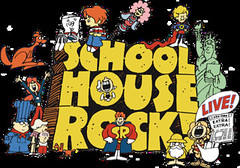 When I was a wee lad, I remember seeing these little animated tv shows that seemed to be mixed in with my Saturday morning cartoons. They were only a few minutes long and were focused on a single subject. But these little shows were unlike anything else on TV. I learned something real. I remembered. I knew, at a very young age, how a bill becomes a law. It was Schoolhouse Rock! and as of January 13th, it turned 40 years old.
When I was a wee lad, I remember seeing these little animated tv shows that seemed to be mixed in with my Saturday morning cartoons. They were only a few minutes long and were focused on a single subject. But these little shows were unlike anything else on TV. I learned something real. I remembered. I knew, at a very young age, how a bill becomes a law. It was Schoolhouse Rock! and as of January 13th, it turned 40 years old.
Speider Schneider is a family friend of David McCall, the creator of the series, and wrote an excellent article about the people and events that made the series happen. From the article:
While it began as a commercial advertising venture by McCall in reaction to his son’s needs and witness to the very solution based in music, when a print workbook version fell through, McCall’s company decided to produce their own animated versions of the songs, which they then sold to ABC (which was already the advertising company’s biggest account) based on a demo animation of the original “Three Is A Magic Number” for its Saturday morning lineup. They pitched their idea to Michael Eisner, then vice-president of ABC’s children’s programming division.
Schneider continues:
Although McCall had a leg up on introducing this innovative idea, it reminds all creatives that a great idea can start with a small spark, sometimes noticed in one’s everyday life and it can grow to greatness. After 40 years, the popularity of Schoolhouse Rock! continues to be enjoyed by generations and holds together, never looking dated or losing its impact.
35 years later, I’m making little shows of my own and credit Schoolhouse Rock! for paving the way. And while the need for this kind of learning and explanation is the same, the environment is different in fundamental ways.
First, McCall’s work could only have been experienced by me and my peers with the help of a TV network and expensive animation tools. The network provided the platform and he happened to have the connections to bring his visions to life. Today we have the Web and comparatively cheap tools for building animations and sharing them with the world. The power of the network is now in our hands.
Second, the animation format was much less cross-generational. In the days of Schoolhouse Rock, cartoons were for kids. I doubt any TV executive could imagine adults being the audience for an animated feature. Today, The Simpsons, South Park and many other shows have proven that adults are a viable market for animated shows. On the web, we see animations becoming one of the most effective explanations and marketing tools for startups.
But some things are remarkably similar.
Schoolhouse Rock shows were all about three minutes long. This length is now a rule-of-thumb duration for many animated explanations. This length is enough to relate valuable information but not so long that people tune out. Also, you know, three IS a magic number:
Also, for the most part, they are purely educational. They were not about Cheerios or Barbie Dolls but grammar, civics and history. From our work at Common Craft to RSA Animate to Minute Physics, these kinds of educational videos endure.
Further, the use of music is a big part of Schoolhouse Rock and something that continues to make learning effective. I recently wrote about an number of awesome examples of this today.
My point here is to say that we live in world where a thousand Schoolhouse Rocks can bloom. We have the tools, the platforms, the audience and know-how to carry the torch, to continue making animated media that educates and enlightens. Let’s build on the work of Mr. McCall and inspire a new generation to see ideas from a more fun and engaging perspective. Here's to 40 more years!